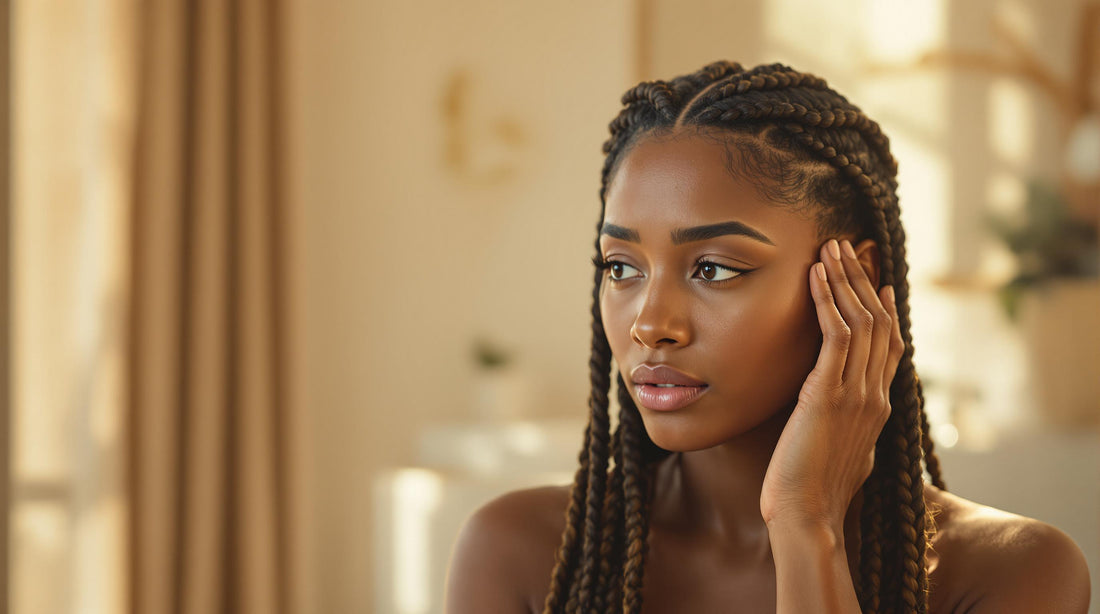- Tight braids can cause scalp tension and irritation. Always go for comfortable styles.
- Dry scalp results from disrupted natural oil distribution. Keep your scalp hydrated with lightweight oils.
- Product buildup and sweat trapped in braids can clog pores. Clean your scalp weekly with a gentle shampoo.
- Synthetic hair allergies may trigger itching. Opt for hypoallergenic options like pre-washed Japanese Kanekalon fiber or rinse synthetic hair with apple cider vinegar before use.
Quick Tips:
- Use hypoallergenic braiding hair.
- Avoid tight braiding techniques.
- Keep your scalp clean and moisturized.
- Address discomfort, bumps, or redness immediately to avoid long-term damage.
By following these steps, you can enjoy your protective styles without the itch.
Why Braided Hairstyles Can Cause Scalp Itch
Dry Scalp from Lack of Natural Oils
Braids can interfere with the distribution of your scalp's natural oils along the hair strands. This disruption often leads to dryness, which is a common reason for itchiness when wearing braids. The good news? It's manageable with the right care [1][2].
Tight Braids and Scalp Tension
Braids that are too tight can put a lot of stress on your hair follicles. This tension often leads to inflammation and irritation at the roots. If ignored, it could even result in gradual hair loss over time [1][2].
Buildup from Products and Sweat
Styling products and sweat can accumulate at the base of your braids, clogging pores and irritating the scalp. The braided pattern makes it harder for these substances to evaporate or be cleaned away effectively [1][2].
Allergic Reactions to Synthetic Hair
Synthetic braiding hair sometimes contains chemicals that can irritate sensitive scalps. This can lead to redness, bumps, and itching. Opting for hypoallergenic options, like pre-washed and pre-stretched Japanese Kanekalon fiber, can reduce the risk of these reactions [1][2].
These are the main culprits behind scalp irritation caused by braids. Next, we'll look at practical ways to prevent and soothe the itch.
How to Stop and Prevent Scalp Itch from Braids
Opt for Hypoallergenic Braiding Hair
Using hypoallergenic braiding hair can help reduce irritation and itching. Brands like Gyal Braids, made from Japanese Kanekalon fiber, are pre-washed and pre-stretched, offering a more comfortable choice for protective styles.
Rinse Synthetic Hair with Apple Cider Vinegar
Synthetic hair often contains chemicals that can irritate the scalp. To remove these, soak the hair in a mix of apple cider vinegar and warm water (equal parts) for 15-20 minutes. Rinse with cool water and let it air dry before use. This step can make a big difference in reducing scalp irritation.
Keep Your Scalp Hydrated
A well-hydrated scalp is less likely to feel dry or itchy. Use lightweight oils like coconut or argan oil 2-3 times a week, apply leave-in moisturizers every few days, and spritz your scalp daily with water-based products to lock in moisture.
Avoid Tight Braiding Techniques
Braids that are too tight can cause discomfort and even damage the scalp. Make sure to communicate with your stylist about how tight the braids feel during installation. Your scalp should feel comfortable, without pain or pulling. Tight braids that cause bumps, headaches, or limit scalp movement should be avoided.
A good stylist will prioritize your scalp's health while ensuring your braids look polished and professional.
sbb-itb-2cead6a
How to Stop the Itch in Protective Styles: 4 Causes and Solutions
Tips for Long-Term Scalp Comfort with Braids
Taking care of your scalp while wearing braids isn't just about quick fixes - it requires consistent attention and thoughtful choices.
Choose the Right Materials and Styles
The type of braiding hair you use matters. Look for options that are pre-washed, lightweight, hypoallergenic, chemical-free, and anti-bacterial to reduce scalp irritation. For example, Japanese Kanekalon fiber is a great choice - it’s gentle on the scalp and helps avoid irritation. When it comes to styles, go for looser options like box braids or Senegalese twists. These styles reduce tension on your scalp and help maintain good circulation.
Prioritize Cleanliness and Hydration
Keeping your scalp clean and moisturized is essential with protective styles. Use a gentle shampoo designed for braided hair to clean your scalp weekly. To avoid dryness and buildup, apply lightweight oils or tea tree-based serums daily. Tea tree oil is especially helpful because of its natural antifungal properties, keeping your scalp healthy and refreshed.
Address Discomfort Quickly
Braids should never cause pain, redness, or bumps. If you notice any of these issues, have your braids adjusted right away. Ignoring discomfort can lead to long-term damage to your scalp and hair follicles, so it’s important to act quickly.
Conclusion
Opting for hypoallergenic braiding hair, such as Gyal Braids made with Japanese Kanekalon fiber, can help reduce irritation and make the braiding process more comfortable. To keep your scalp healthy, focus on regular moisturizing, gentle cleansing, and avoiding overly tight braids.
Your scalp deserves attention and care. If you notice ongoing itching, redness, or discomfort, address it promptly to prevent further issues [1]. Using good-quality hair products and maintaining proper care routines will leave you with stunning braids and a healthy scalp.

